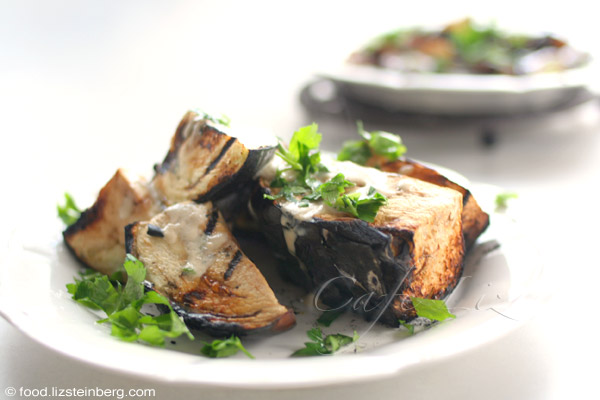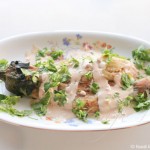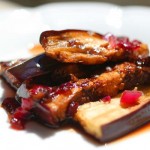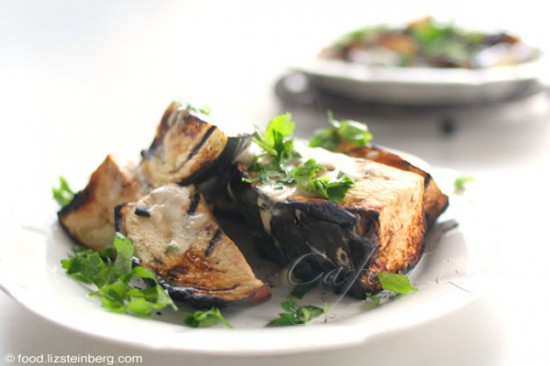
In a nondescript junction in neighboring Givatayim sits a legend of a shop known as Oved’s sabich. Oved rose to fame not due to the quality of his sabich — fried eggplant — but due to his playful use of the Hebrew language.
If someone asks, “Have you been to Oved?” the appropriate answer is yes. Admitting that you haven’t brings incredulity. Admitting that you’ve been there only once is passable, but still surprising.
Oved is such an institution that friends inevitably suggest that I take tourists there, even if there’s not much else of note nearby. But I don’t think a tourist would get it: Some things just don’t translate.
When you go to Oved, you communicate your order using his lexicon. Would a tourist, for instance, appreciate when Oved asks if you want bitzul — which, if it were a real word, might translate as something like “onionizing”? And even if the tourist understood Hebrew, would he understand that when Oved asks for the score in the derby, he wants to know how many spoonfuls of red pepper sauce and how many spoonfuls of amba mango chutney you want — because red is the color of Hapoel, and yellow is Maccabi, and this is a reference to the game between the two soccer teams?
None of this says anything about the actual sabich, which comes served in a pita along with a hard-boiled egg (“bitzbutz“) and salad (“silut“). No champion goes unchallenged, and there’s a debate over whether Oved’s sabich deserves its reputation — some people swear by it, while others deride it as all show and sniff that he uses — gasp! — industrial hummus.
What would a tourist think? Without a finely tuned ear, would he think that it’s just another nondescript food stand in a nondescript Tel Aviv suburb?
Hamiznon shel Oved, Sirkin 7, Givatayim. Open weekdays from 9 A.M.-midnight, Fridays until 4 P.M., and Saturdays after Shabbat.
Oved in action:
Iraqi breakfast
People have made much over the term sabich, speculating that once there was a person by that name, or that it’s an acronym for salad-egg-eggplant (in Hebrew). But the truth probably is much simpler. Sabich means breakfast, as any Iraqi knows (sabakh is morning in classical Arabic); the dish was brought over along with the massive Iraqi-Jewish immigration. My former roommate Ron recalls a childhood of fried eggplants with salad on Saturday mornings, which his family simply called Iraqi breakfast.
There’s an oft-quoted Middle Eastern proverb that claims a woman needs to know 100 different ways to cook an eggplant. Regardless of what you think of such a statement, the truth is that there are countless ways to prepare the purple beasts, and I’m always discovering new ones. One comes from Irit, who has a small restaurant in the Yemenite quarter.
Modern eggplant varieties don’t need to be salted and sweated a day in advance to remove bitterness, but doing so keeps them from absorbing excess oil in the frying process, Irit says. For that reason, she won’t prepare sabich on the fly. When forced to prepare eggplant in any case, she chops it into large chunks and sticks it straight on the flame, and it comes out soft, smoky and completely oil-free.
Many of us think eggplant dishes are better when you’re using the fat, fleshy variety known as baladi (local, “of the people”), which often look bizarre and misshapen when compared to their elongated cousins. Is there a real difference in taste? To be honest, I’m not sure, but people swear by the baladis.
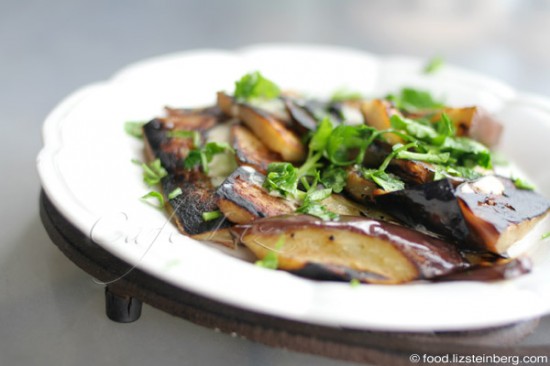
Sabich
an eggplant
salt
oil for frying
tahini (if you’re using raw tahini — mix 1 part tahini, 1 part water)
fresh lemon juice (at least 1 lemon per eggplant)
fresh parsley
coarse salt
Prep the eggplant a day in advance — slice along the length of the eggplant into strips (as opposed to cutting across the eggplant, to make rings), and chop the strips into rectangles about half the size of your palm. Salt and arrange in a colander with a weight on top, such as a plate, and let the eggplant pieces sweat out their liquid.
Heat oil in a frying pan, and fry the eggplants until golden and soft. Add more oil if needed to keep them from sticking to the pan.
If the eggplants are particularly oily, you can leave them on a paper towel to absorb the excess.
Serve with a generous topping of tahini, lemon juice and parsley, and sprinkle of coarse salt (the above photo).

Grilled eggplant chunks
an eggplant
tahini (if you’re using raw tahini — mix 1 part tahini, 1 part water)
fresh lemon juice (at least 1 lemon per eggplant)
fresh parsley
coarse salt
Chop the eggplant into large chunks — some of exposed surfaces will be inedible, so therefore larger pieces are better.
Arrange the chunks directly on a gas burner or another flame source. (I’m serious — see the photo.) Try to have the skin sides facing down, directly on the flame. If you have a metal basket used for roasting things, you can use it here.
Grill the eggplant chunks until they become soft — a fork should pierce them easily.
Serve with a healthy topping of tahini, lemon juice and parsley, and a sprinkle of coarse salt (top photo).
When eating, don’t eat the charred parts, just the white flesh, which should be moist and soft.

